Antique Stereo View Cards for Parallel Viewing.
Stereo view cards had two pictures mounted for parallel viewing, on 7 x 3.5 inch heavy cards, usually curved slightly with axis along the long length. The pictures were taken with a two-lensed camera, recording the subject from two points of view separated by about 2.5 inches, duplicating what our two eyes see. In some cases we have corrected alignment and matched the image tone where one picture may have faded.This web page is an experiment. My other galleries have pictures for cross-eyed free viewing. Not everyone can do that. On this page the pictures have been resized smaller and arranged so that the center pair can be viewed with parallel viewing. Resize your browser so it uses the full width of your monitor. On most newer laptop monitors these pictures will be 2.5 inches apart, just right for normal human eyes. The left pair and right pair are viewable by the cross-eyed method, and this may be useful for those just learning the cross-eyed method.
When you can learn to view these in 3D, you may prefer these pictures formatted larger, for cross-eyed viewing. It is also a good place to see these pictures in 2-D at higher resolution. Click here to switch.
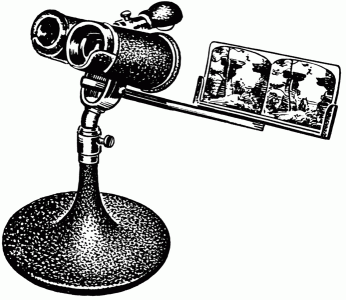 | 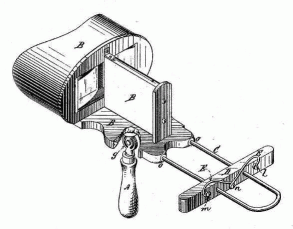 |
| Early form of stereoscope. | The Holmes-Bates Stereoscope US patent US00232649 |
|---|
Early history of stereo photography.
Stereo photography flourished in the early history of photography. These images are from stereo view cards, and these are often in sad condition. Yet we are fortunate to have this glimpse into an era when photography was successfully done under conditions that would deter all but the most dedicated photographer today.


Wet-Plate Photographer in the Field. (c. 1870) Stereo photography is as old as photography itself. Frederick Scott Archer (1813-1857) invented the wet-plate process in 1851. During the "wet-plate" era outdoor photography was best, for exposures in sunlight could be 20 seconds or more. But the photographer had to take a darkroom with him. Here we see the photographer and his tripod mounted stereo camera. His assistant has a portable darkroom also on a tripod. The glass plate was coated with collodion (nitrated cotton dissolved in alcohol and ether), soaked in potassium bromide, sensitized in silver nitrate (in the dark), and then loaded (still in the dark) into a light-tight holder. The holder was transfered to the camera, still damp, then exposed. It then had to be developed immediately (before it dried) in a ferrosulfate bath, again in the darkroom, promptly. It was rinsed, then fixed in potassium cynanide (hypo). Since exposures were long, cameras didn't have sophisticated shutters. The photographer simply removed the lens caps for the required time. (Some cameras had a simple swinging flap shutter.) Far from the casual snapshooting of today.


S17 Photographer's Studio. (c. 1870?) A well-equipped photographer's studio needed a skylight to admit lots of sunlight, portable adjustable reflectors (in background), and decorative curtains. We see here the camera on an ornate tripod. A stereo lensboard is on the desk. The bird cage on the desk may be a prop. The photographer and his assistant (probably his wife) are relaxing on a slow day.
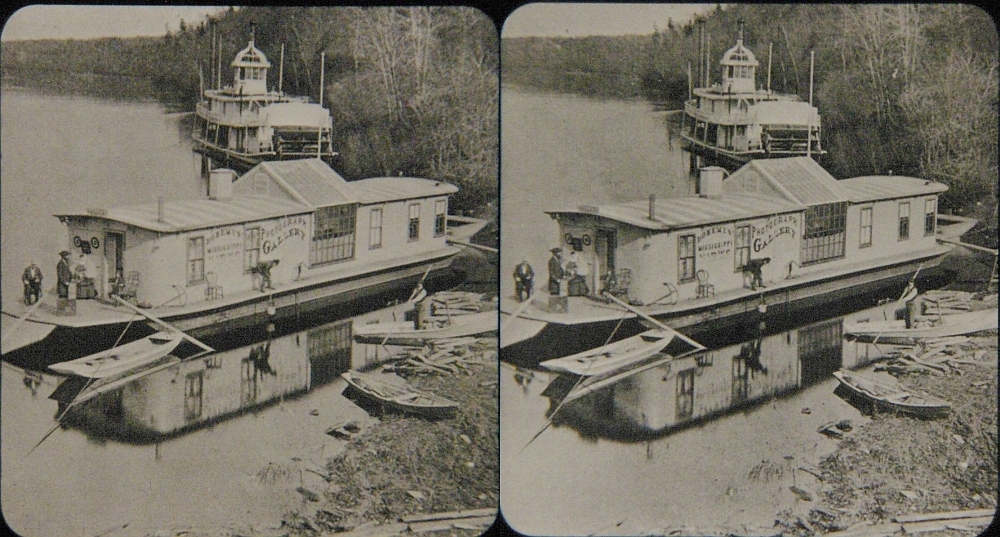

Floating Photographic Gallery of J. P. Doremus. 1872. This enterprising photographer has his whole photographic operation on a barge in the river. Note the studio portion in the middle, with skylight and glass-windowed walls. I have no information about how Mr. Doremus used this studio, but it seems wonderfully practical. He could maneuver the boat on the water so that the sunlight came into the studio at the desired angle, enhanced by reflected light from the water surface.
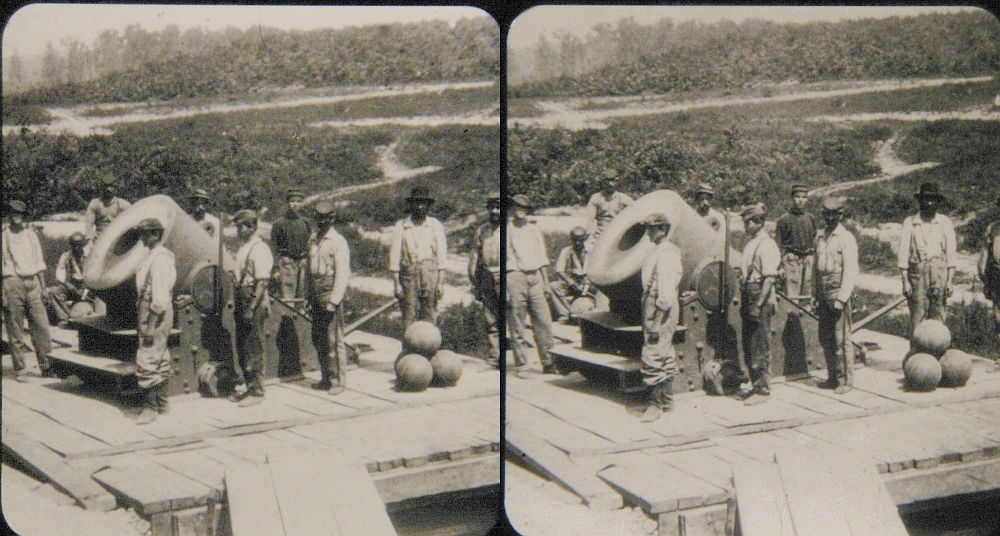

#10 The 13" Mortar "Dictator"—Grant's Military Railway (before Petersburg). WPEC. VM13-17. From the Library of Congress collection. The Civil War was documented by Matthew Brady's photographers, in stereo. One of these mortars was featured in the Buster Keaton film The General. Matthew Brady seldom ventured far from his elegant studios in Washington, D.C. The civil war photography was done by his photographers, notably William Henry Jackson and Timothy Sullivan. After the war they went on to document the Westward expansion in stereo photographs.
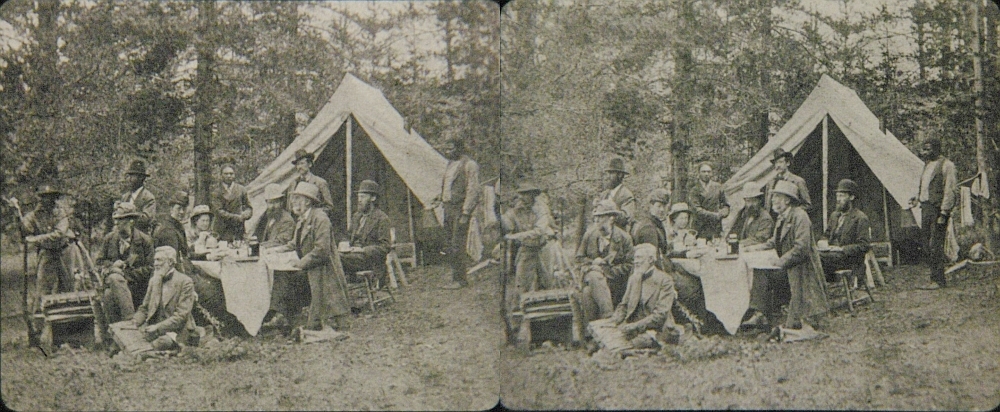

Camping Out, Colorado. Kilburn 2951. Reprinted and re-issued view cards often have incomplete and misleading labeling. A little digging reveals that this is no ordinary camping party, but an 1877 foray into the Colorado Rockies by a team of botanists, their wives and friends, a guide and two negro servants. The Harvard botanist Asa Gray [1810-1888] is seated on the ground, with a drying stack for plant specimens in his lap and other plant specimens lying nearby. Sitting near him is botanist Sir Joseph Dalton Hooker [1817-1911], visitng from England. The photograph was taken by William Henry Jackson [1843-1942] at La Veta Pass, Colorado. You can see a clearer and larger non-stereo picture of this scene at the Asa Gray Herbarium site of Harvard, second item. Click here for a high quality scan of that picture. Note that there are significant differences between the two, suggesting that Jackson posed his subjects and then took a number of photographs of the same scene.
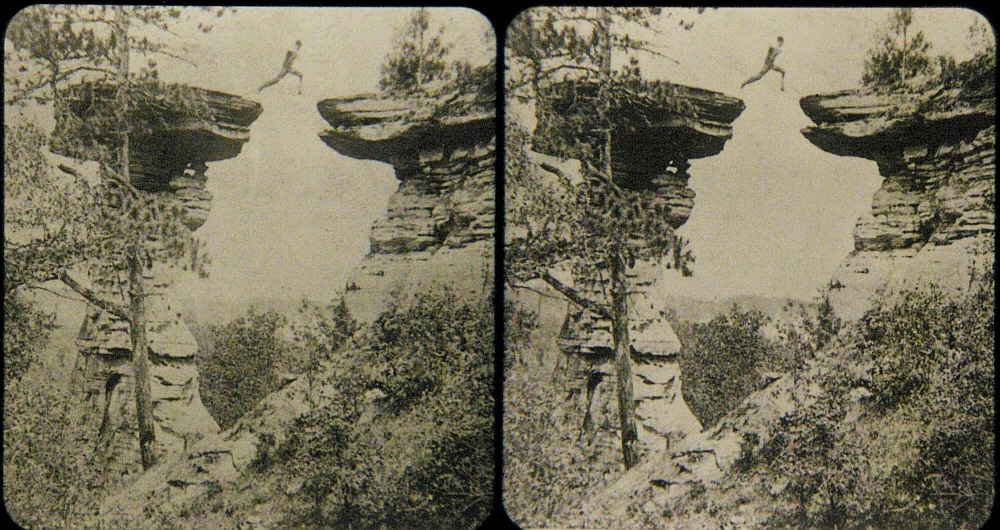

S45 Jumper at Stand Rock, Delles of the St. Croix, Wisc. by Henry Hamilton Bennett. 10269 © 1895 Kilburn. Gelatin dry plates, introduced in the 1880s, were much more light sensitive. Short exposures were now possible, and cameras acquired shutters. At last action could be photographed, and photographers (and daredevils) exploited the possibilities. [Note that this same picture is depicted in the drawing of the stereo viewer at the top of this document.]
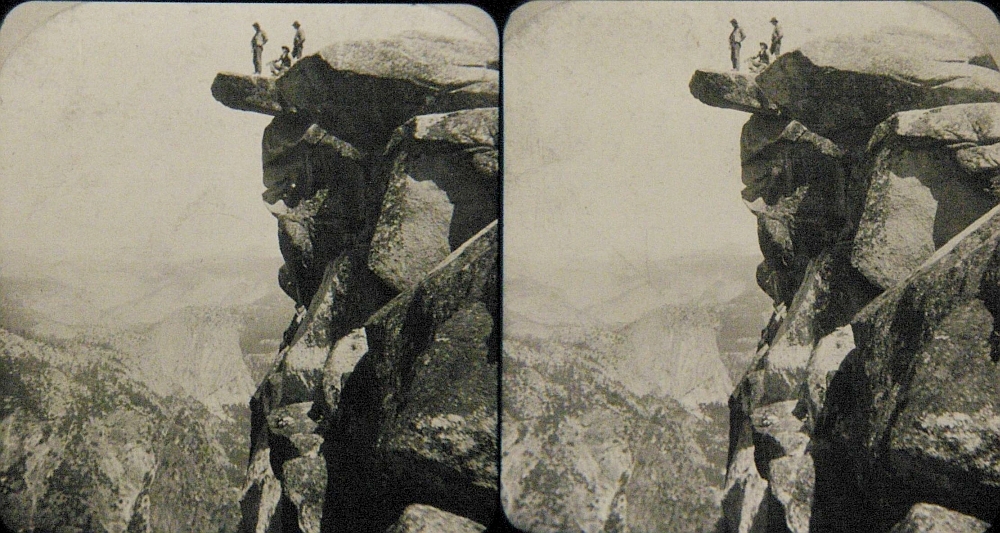

S49 Glacier Point, Yosemite Valley, Cal. 5004 Keystone © 1907 Lingley. If there was a high point, outcropping, or precarious perch, stereo photographers found it.


S53 Balancing Rock (300 tons) Garden of Gods, Colo. © 1894 Strohmeyer and Wyman, Underwood and Underwood. Tourists found humor in balancing rocks. Note how the woman is helpfully compensating for the extra weight of the man. A little physics here.
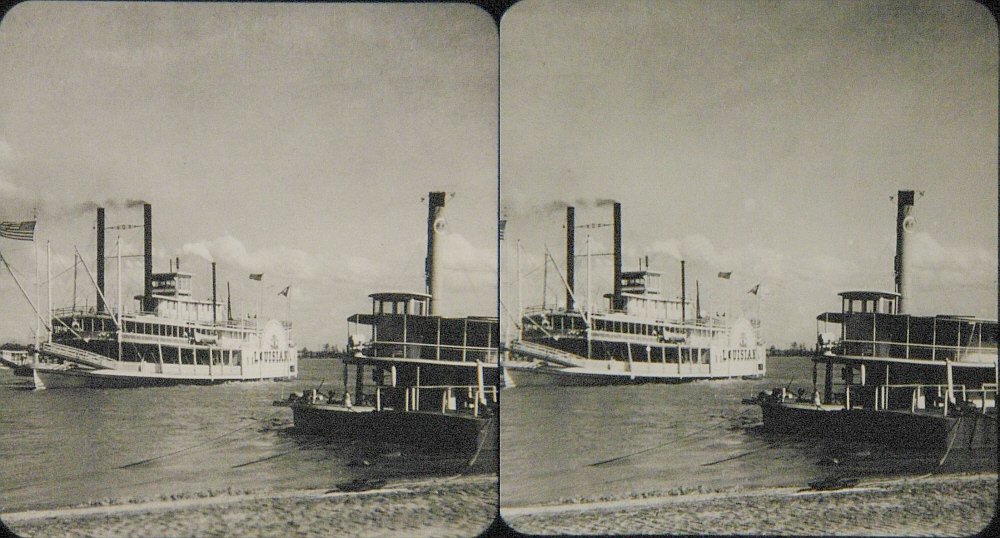

#26 Steamboating on The Father of Waters, St. Louis. © 1904.
Victorian parlor entertainment.
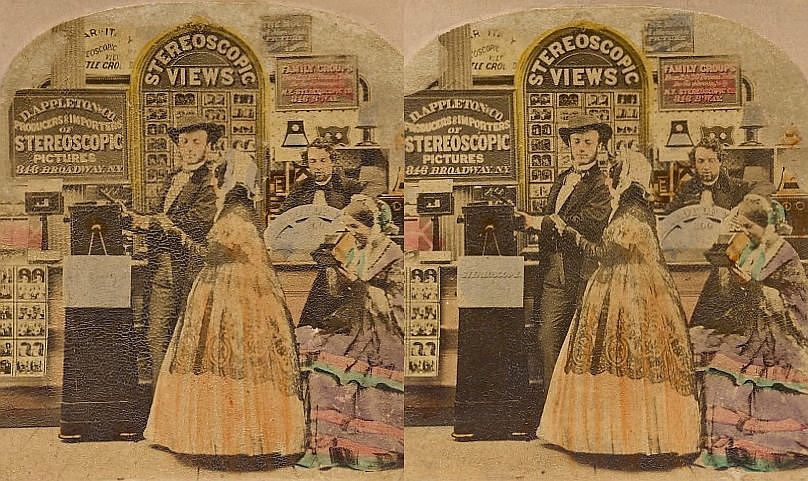

The interior of D. Appleton's stereoscopic business in New York City in about 1859. Shown are a variety of viewers that were popular during the Civil War. Just to the left of the man on the left is an upright viewer called a Becker viewer. The woman on the right is holding a Brewster viewer. All of these viewers were quite expensive and beyond the means of the typical working person. Oliver Wendell Holmes and Boston photographer Joseph L. Bates invented the inexpensive "Holmes-Bates" viewer that made viewing these images affordable to a larger audience.


In the late 18th century, family entertainment consisted of a collection of stereo view cards, some stereoscopes to view them, and, in wealthier households, a cabinet viewer. This picture is of a reconstruction of a Victorian parlor, at the Smithsonian Institution Museum of American History.


16332 Cutting department of B. W. Kilburn & Co's Celebrated Stereoscopic View Factory. © 1905 by B. W. Kilburn.
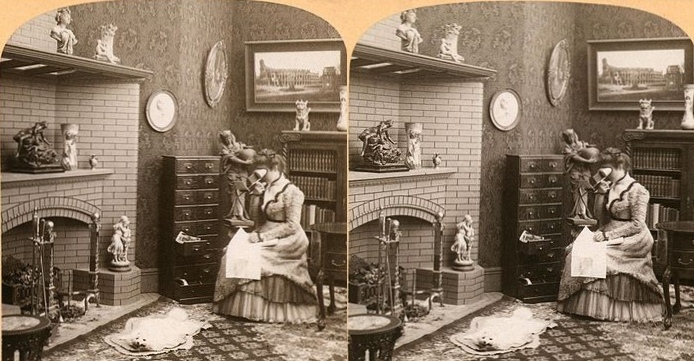

The Stereograph as an Educator—Underwood Patent Extension Cabinet in a home Library. Copyright 1902 by Underwood and Underwood.
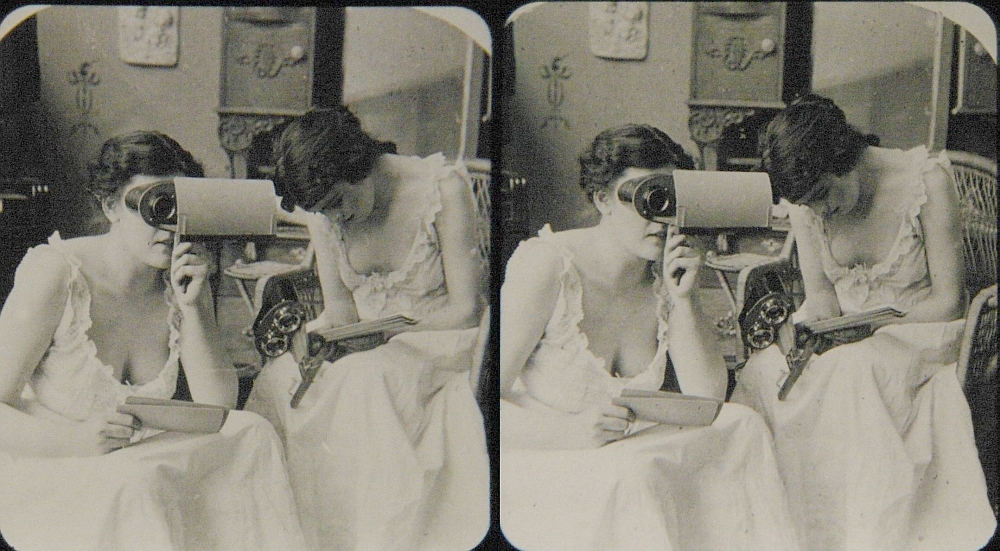

#23 An Interesting Picture. Sometimes view cards show stereo equipment, such as these two ladies using what appear to be stereoscopes of quality a cut above those usually found in homes. I think the title was intended to have double meaning. I inquired whether anyone knew the make and model of the stereoscope in the lady's lap. I got an email from someone who has one. "It is a "Stereo-graphoscope" viewer that was made in 1896 by the H.C. White Co. exclusively for Sears. The lenses are nickel plated, and they are adjustable. It is rare, and I was lucky to have found mine in a yard sale."


Evolution of the sickle and flail. 33 horse team combined harvester. Walla Walla, Washington. Copyright 1903 by Underwood and Underwood.


The Great pyramid of Gizeh, a tomb of 5,000 years ago, from S.E. Egypt. Stereograph. NY: Underwood and Underwood, 1908.
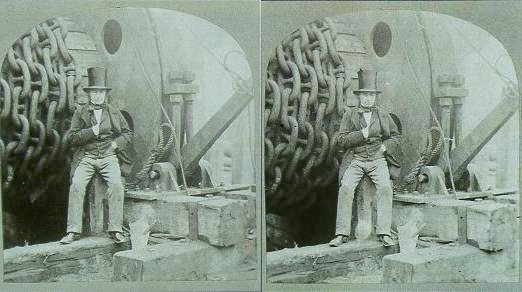

Unidentified image. Isambard Kingdom Brunel (1806-1859), British engineer; designer of the Bristol Suspension bridge, the SS Great Britain, the Great West Railway (London to Bristol) and ships such as the Great Eastern. Here he's posing by the anchor chain of the Great Eastern during her construction at Millwall. This image is often seen reproduced 2d in books. [Thanks to Alexander Lentjes for identifying this picture.]


Gossip—At every sip a reputation dies. Copyright 1899 by Strohmyer and Wyman.


S50 Ludgate Hill, London, England. c. 1896 S. & W. Underwood. Travel pictures were very popular, since most people could not afford travel to other countries, but could easily afford stereo viewcards of exotic places.
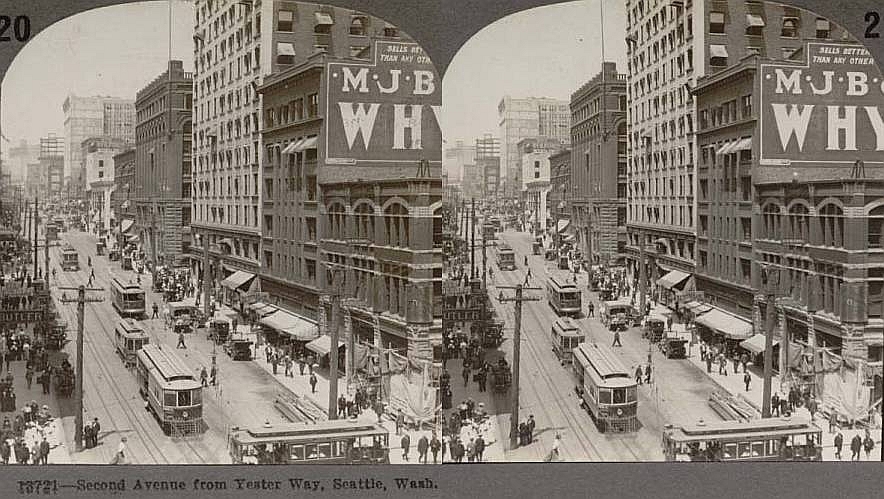

13721 Second Ave from Yester Way, Seattle, Wash. Copyrighted. Keystone View Company #220. Cards in condition this good are usually reprints (copies) from earlier cards. While the card says "coyrighted", no date is given. The photographic image is a single photographic print, die-cut to the "arched window" shape. Earlier cards had two separate photos hand-aligned when they were glued to the card stock. While view cards of cities and landscapes have historic interest, they, like this one, have no depth, for everything in the scene is beyond 50 feet, they are no better than 2 dimensional photos. This one is part of a set of 600 cards reprinted from the Keystone archives for use in schools. Lantern slides were also available. A full list of the cards in this "600 set" is given in the printed teacher's guide Visual Education. The "600" Set was sold to schools between 1905 and 1924.
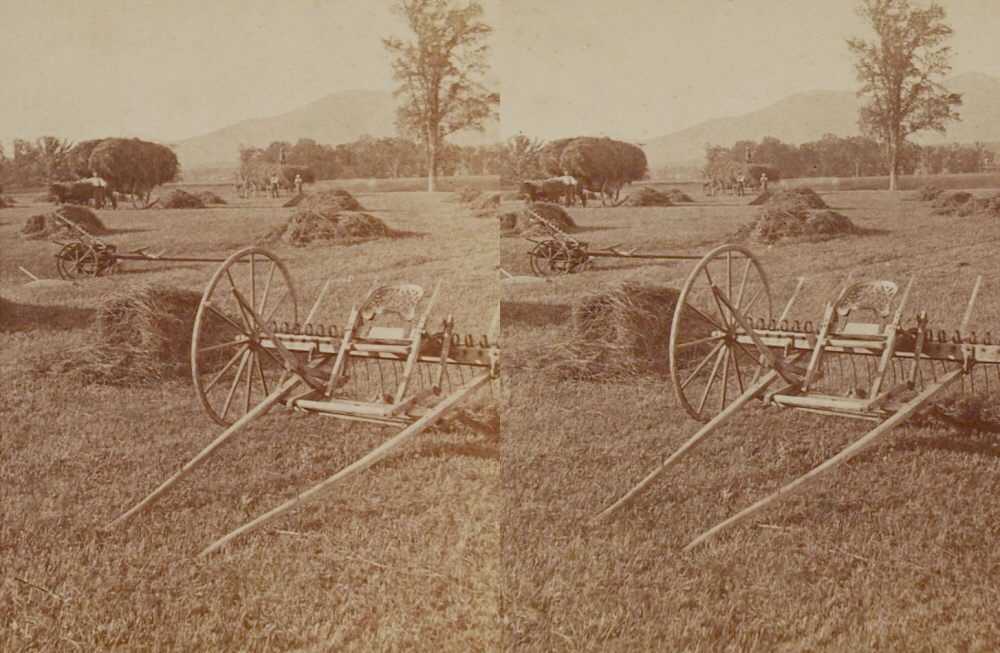

No title. J. W. & J. S. Moulton, Salem, Mass. New Series American. Stereo views often showed everyday activities using the machinery of the time. A few small blemishes have been retouched in this digital copy.
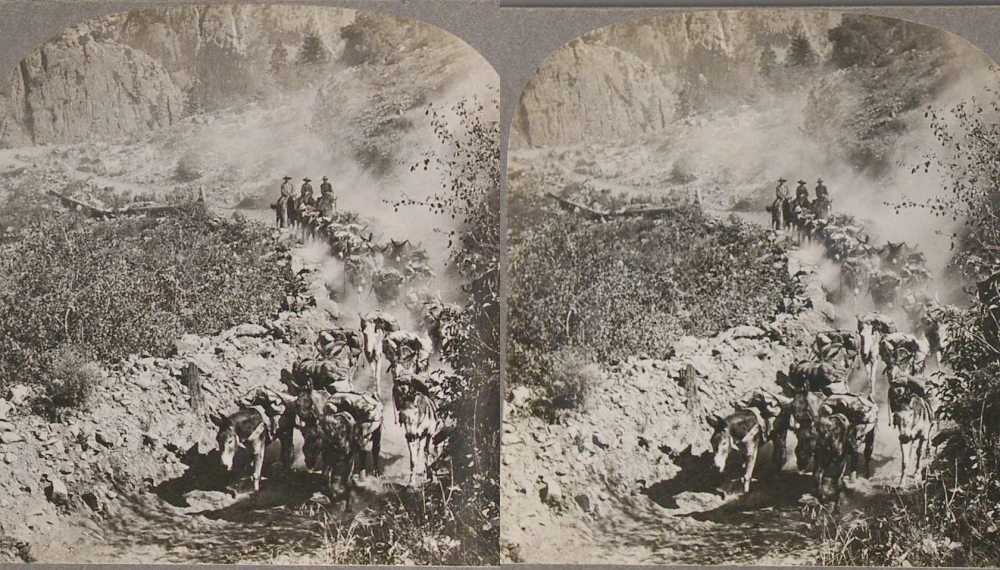

9005 Burro Train—Gold from Virginius Mine near Ouray, Col., U.S.A. Keystone View Co, c. 1898 by B. L. Singley. Cards were often reprinted by copying from earlier cards. These often had muddy dark areas and excessive contrast. I have improved the gamma on this one to bring out details.


Track workers on a hand car in the Utah desert. E. & H.T. Anthony Stereoview #7148.


No title. This may not be a commercially issued card. Often a viewcard is in dismal condition, with faded areas and foxing spots. Still, it may show something of historical interest. George Pek writes: "I think your stereo ... is possibly the "Topaze" British Crusier. It is the only ship with three smoke stacks of all 21 ships of the Channel Fleet." See Topaze Photos.
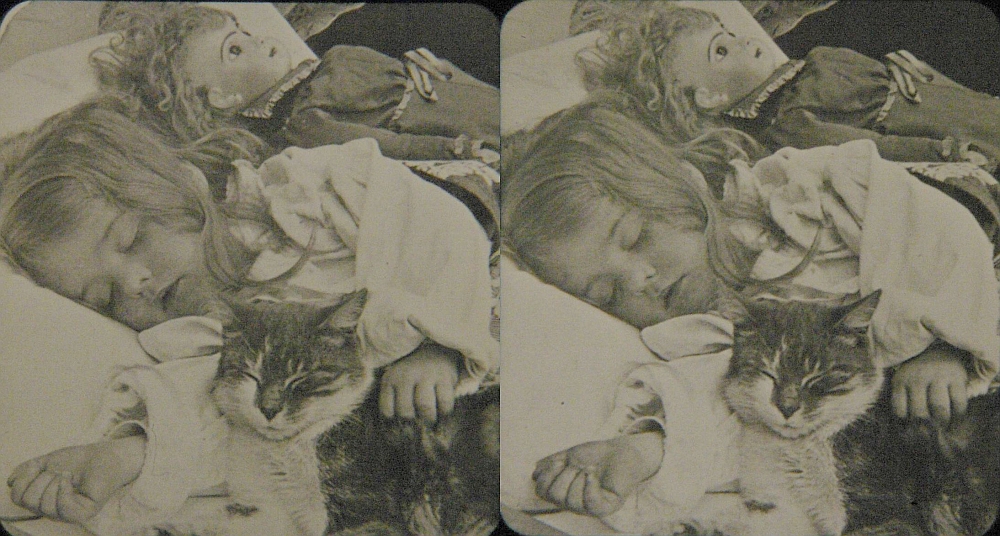

Fast friends passing the gates of Sleepy Land. Copyright 1905 by Underwood and Underwood.


Tired of Play. c. 1898 by Strohmeyer and Wyman. Pictures of children were popular in Victorian times, especially when shown sleeping with their dolls, toys, or pets. This picture was so badly framed that I had to correct the stereo window by cropping.
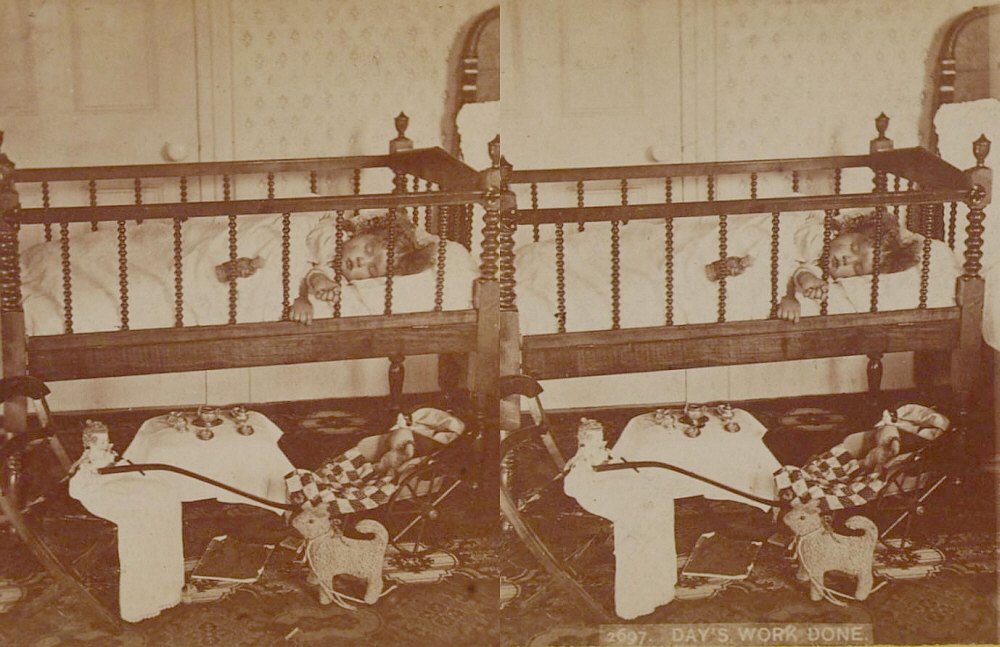

2697 Days Work Done. Young Folks Series. C. W. Woodward, Publisher, Rochester, NY. This one required gamma correction, for the card's image was so muddy that details of the toys could not be seen clearly. Note the table set for tea.


Fairbanks residence, by J. Bullock is handwritten on the back of this card. This card was in sad condition. It had mildew spots, the two pictures had faded unevenly, and the mounting was carelessly done. Still, it is a record of an architectural style that was considered quite grand in its day.


86. Reducing the surplus. "Now pull hard!" Copyrighted 1899 by T. W. Ingersoll Late on the scene were color lithographed view cards. These were usually printed on thin cardboard, and flat. The printing process was three-color, like pictures in magazines, and color registration wasn't always good. The pictures were usually "colorized" from black/white originals. Sometimes these cards were later trimmed for mounting in penny-arcade viewers that could display a sequence of pictures, often telling a story. This process often reduced the overall size of the card and punched a rectangle out of the lower edge center, for the viewer's guide rail. Antique dealers often inflate the prices of these, to a price not related to quality, but simply because of the novelty of color.


On the Beach at the Bath House. 1902. T. W. Ingersoll. Turn of the century swimwear models. The dressing rooms were on wheels.(Image courtesy of Brenda Heberling.)


Liberated Woman. The liberated woman relaxing while her husband does the housework.


Japanese Garden. Color lithograph.


3865 Charming Geisha Girls of Japan in a lovely garden at Hiroshima. ©1906 by H. C. White.
More antique view cards to come. Watch this page.
For a nice collection of over a thousand stereo view cards, see: The World of Stereo Views.
More cross-eyed stereos in 3d Gallery One.
Still more cross-eyed stereos in 3d Gallery Two.
Building a digital stereo close-up photography system in 3d Gallery Four.
Review of the Loreo stereo attachment 3d Gallery Five.
Review of the Loreo macro adapter, 3d Gallery Five B
The Loreo stereo attachment—improved 3d Gallery Five C.
The Loreo LIAC attachment as a 3d macro device, 3d Gallery Five D.
Wildlife photography in your backyard, 3d Gallery Six.
A home-built digital stereo camera using mirrors 3d Gallery Seven.
Stereo close-up photography in your garden 3d Gallery Eight.
Stereo photography in your aquarium 3d Gallery Nine.
Stereo digital infrared photography 3d Gallery Ten.
Wider angle stereo with the Loreo LIAC 3d Gallery ll. A failed experiment.
Review of the Fuji FinePix REAL 3D W1 camera. 3d Gallery 12.
Macrophotography with the Fuji 3D camera. 3d Gallery13.
Panoramic stereo photography. 3d Gallery 14.
Tips for stereo photography with the Fuji 3d camera. 3d Gallery 15.
Mirror methods for stereo photography. 3d gallery 16.
The Fuji 3d macro adapter using mirrors, by Paul Turvill.
The Fuji 3d macro adapter with flash! 3d gallery 17.
Critters in stereo. 3d gallery 18
Wide angle stereo. 3d gallery 19.
Telephoto Stereo. 3d gallery 20.
2D to 3d Conversion. 3d gallery 21.
Stereos from outer space. 3d gallery 22.
Review of the Panasonic Lumix 3d digital camera. 3d gallery 23.
Reverberant flash for shadowless lighting.
Digital stereo photography tricks and effects.
Shifty methods for taking stereo pictures.
Stereoscopy with two synchronized cameras by Mike Andrus.
Guidelines for Stereo Composition.
Return to the the 3d and illusions page.
Return to Donald Simanek's front page.